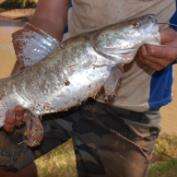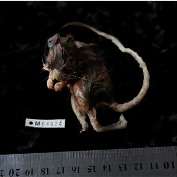A lesser salmon catfish. Credit: Murdoch University
Large catfish in a desert river in the Pilbara are eating native mice when available, Murdoch University researchers have found.
Previously it was thought the diets of lesser salmon catfish consisted primarily of insects, crustaceans and plants, but stomach examinations revealed a number had consumed native spinifex hopping mice.
Lead researcher Dr Erin Kelly, from the Centre for Fish and Fisheries Research at Murdoch, said it was likely the catfish were opportunistically gaining access to the mice.
"Dryland rivers experience extreme cycles of drought and flooding, which leads to a great variation in the type and amount of food available at certain times," said Dr Kelly.
"The catfish may be altering their diets according to what's available. This mouse species has been reported to construct deep burrow systems in the sand of riverbanks. If a burrow of mice is flooded and collapses into the river, the catfish are likely to be taking advantage.
"Population booms are also reported for the spinifex hopping mouse, often within three to 10 months after periods of rainfall. The fish we collected for this study were caught during the early dry season – a time of expected population growth for this mouse species.
"Both species are nocturnal, and it is also possible that the catfish are actively hunting mice on the riverbank."
A spinifex hopping mouse recovered from the stomach of one of the catfish. Credit: Murdoch University
Lesser salmon catfish are widely distributed in northern Australia, and the spinifex hopping mouse occurs throughout the central and western Australian arid zones.
Dr Kelly and her co-researchers caught 18 lesser salmon catfish from the Ashburton River, and found the small mammals at various stages of digestion within the stomachs of eight of the fish. In two of the catfish, the remains of three small mammals were present in each stomach.
Mammals have been infrequently reported in the diets of Australian catfish and other native northern Australian fish species like mouth almighty, but this is the first report of high levels of terrestrial mammal consumption by any Australian catfish.
Dr Kelly said understanding the links between aquatic and terrestrial food webs is vital to our understanding of river and riverbank ecosystems.
"A greater understanding of the way these ecosystems function will assist in the management and conservation of these habitats," she added.
"This is of increasing importance as Australia's climate warms. Changing weather patterns and the increasing challenge to meet growing water demands is likely to disrupt the flow of many of Australia's rivers, and threaten the unique biodiversity of these ecosystems.
"Understanding whether species like the lesser salmon catfish can adapt to their changing environment, and how the successful ones do it, will help us to conserve these creatures."
More information: Erin Kelly et al. Mammal predation by an ariid catfish in a dryland river of Western Australia, Journal of Arid Environments (2016). DOI: 10.1016/j.jaridenv.2016.08.005
Journal information: Journal of Arid Environments
Provided by Murdoch University
























